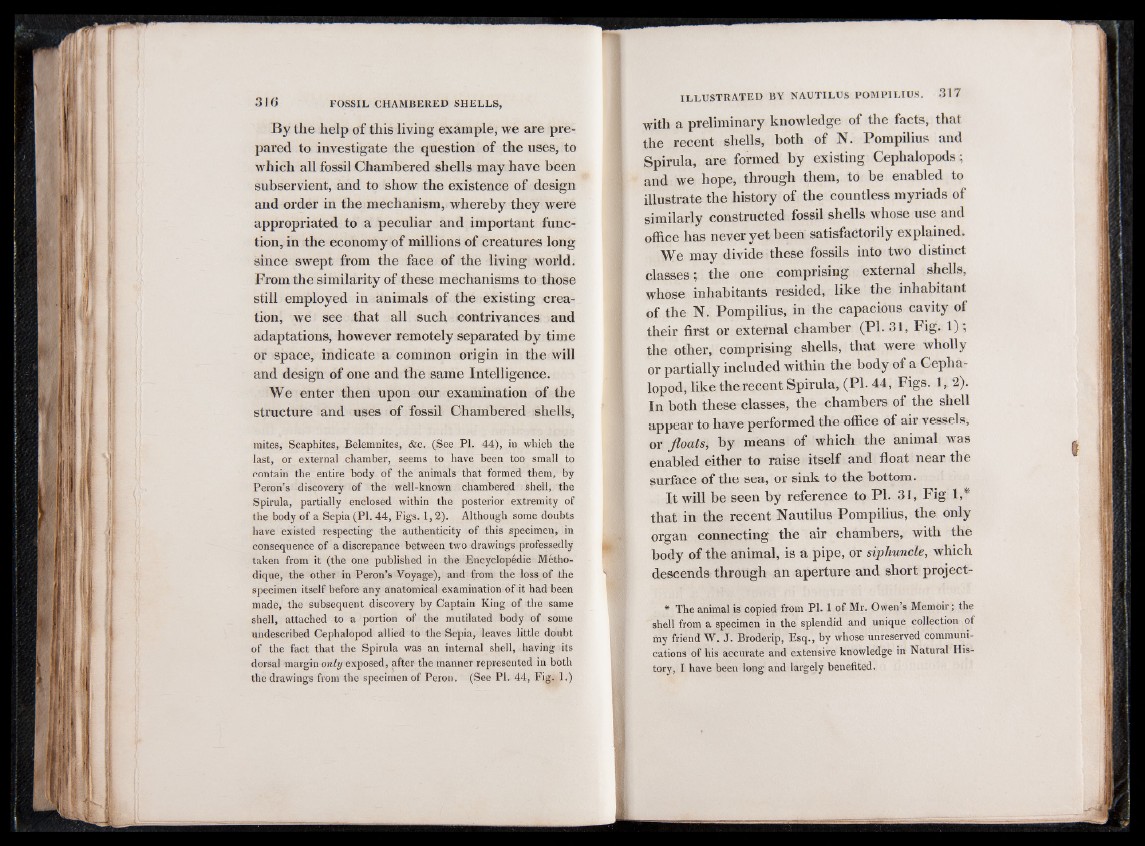
By the help of this living example, we are prepared
to investigate the question of the uses, to
which all fossil Chambered shells may have been
subservient, and to show the existence of design
and order in the mechanism, whereby they were
appropriated to a peculiar and important function,
in the economy of millions of creatures long
since swept from the face of the living world.
From the similarity of these mechanisms to those
still employed in animals of the existing creation,
we see that all such contrivances and
adaptations, however remotely separated by time
or space, indicate a common origin in the will
and design of one and the same Intelligence.
We enter then upon our examination of the
structure and uses of fossil Chambered shells,
mites, Scaphites, Belemnites, &c. (See PI. 44), in which the
last, or external chamber, seems to have been too small to
contain the entire body o f the animals that formed them, by
Peron’s discovery of the well-known chambered shell, the
Spirula, partially enclosed within the posterior extremity of
the body of a Sepia (PI. 44, Figs. 1,2 ). Although some doubts
have existed respecting the authenticity of this specimen, in
consequence of a discrepance between two drawings professedly
taken from it (the one published in the Encyclopédie Méthodique,
the other in Peron’s Voyage), and from the loss of the
specimen itself before any anatomical examination of it had been
made, the subsequent discovery by Captain King of the same
shell, attached to a portion of the mutilated body of some
undescribed Cephalopod allied to the Sepia, leaves little doubt
of the fact that the Spirula was an internal shell, having its
dorsal margin only exposed, after the manner represented in both
the drawings from the specimen of Pérou. (See PI. 44, Fig. 1.)
ILLUSTRATED BY NAUTILUS POMPILIUS. 317
with a preliminary knowledge of the facts, that
the recent shells, both of N. Pompilius and
Spirula, are formed by existing Cephalopods •,
and we hope, through them, to be enabled to
illustrate the history of the countless myriads of
similarly constructed fossil shells whose use and
office has never yet been satisfactorily explained.
We may divide these fossils into two distinct
classes; the one comprising external shells,
whose inhabitants resided, like the inhabitant
of the N. Pompilius, in the capacious cavity of
their first or external chamber (PI. 31, Fig. 1);
the other, comprising shells, that were wholly
or partially included within the body of a Cephalopod,
like the recent Spirula, (PI. 44, Figs. 1, 2).
In both these classes, the chambers of the shell
appear to have performed the office of air vessels,
or floats, by means of which the animal was
enabled either to raise itself and float near the
surface of the sea, or sink to the bottom.
It will be seen by reference to PI. 31, Fig l *
that in the recent Nautilus Pompilius, the only
organ connecting the air chambers, with the
body of the animal, is a pipe, or siphuncle, which
descends through an aperture and short project-
* The animal is copied from PI. 1 of Mr. Owen’s Memoir; the
shell from a specimen in the splendid and unique collection of
my friend W. J. Broderip, Esq., by whose unreserved communications
of his accurate and extensive knowledge in Natural History,
I have been long and largely benefited.